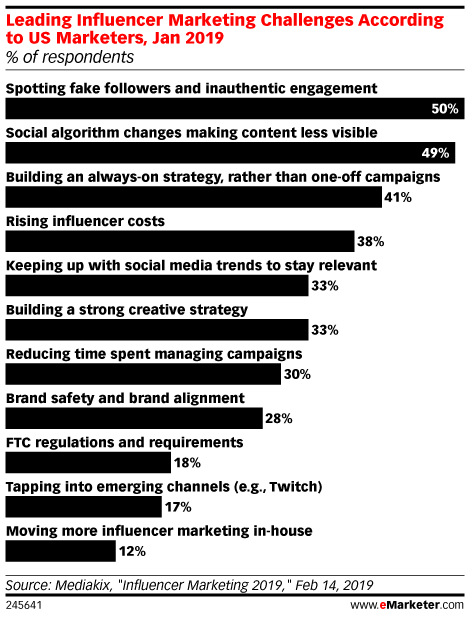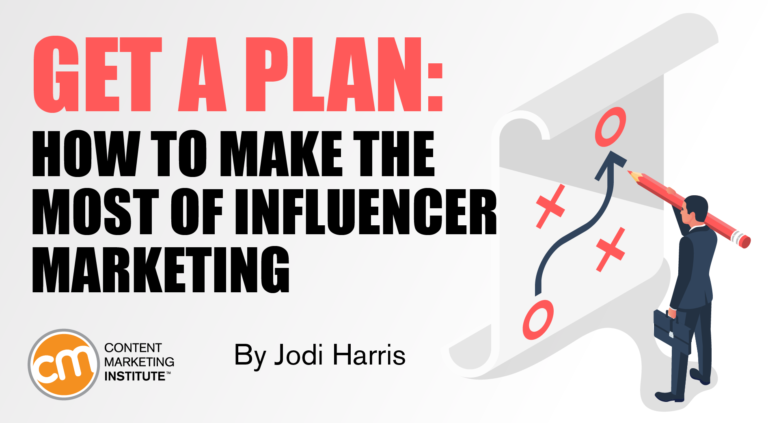That means you may have to do a little extra legwork to convince your content stakeholders to support a promotional technique not fully under your brand’s control. Further, the Influencer Marketing Hub study found that 82% of marketing professionals who use the technique believe that the quality of the customers driven by these campaigns is better than from other forms of their marketing. Data privacy concerns Many agencies and platforms that connect brands with potential influencers rely on audience data to determine whether an influencer’s following will engage with a certain brand. Build your influencer infantry Your brand’s ability to find success with this technique largely depends on the strength of the influencer relationships you develop and how you enlist their assistance in your content initiatives. For example, Cisco leveraged influencer marketing by enabling its internal evangelists to share highlights of their work experience with Cisco’s Snapchat network. According to former community manager Bridget Burns, the company invites Tom’s superfans to join its community of people eager to participate in the brand’s content initiatives. “We share content and tell them that if they like it, they can share it with their followers. Go beyond the social content sphere While most marketers might consider influencer marketing to be synonymous with the untamed nature of social media content, that doesn’t have to be the case. Influencer roundup post: In this technique, your content team collects and features the thoughts of industry influencers who have spoken on a relevant topic. You can amplify naturally occurring acts of brand advocacy with content that promotes your promoters (and, by extension, your business).

Before online influencer marketing became a major “thing” (and way before it was legitimized as a structured technique or a lucrative career path), it was known as word-of-mouth marketing.
As a kid, I learned about the concept by way of a popular commercial for Faberge Organics, in which a smiling Heather Locklear shared her secret for bouncy hair with two friends, who in turn told two friends, and so on, and so on …
Though the underlying mechanisms of the “tell-a-friend” technique remain largely unchanged, social media has fueled its evolution into a strategic discipline infinitely more targeted, impactful, and scalable than anything Faberge’s marketing team could have predicted.
But successful influencer campaigns are tangled and tricky to manage these days. If you want today’s social tastemakers to amplify your content’s reach and influence, keep the following considerations and cautions in mind.
Speak your influencer truth to stakeholders
Whether or not compensation is involved, influencer marketing relies on securing the participation of independent promoters who are responsible for their interactions – for better or worse. That means you may have to do a little extra legwork to convince your content stakeholders to support a promotional technique not fully under your brand’s control.
How can you make the case for adding influencers into your content mix? Here are a few facts you can cite as compelling evidence:
- Your marketing peers believe in it: In Influencer Marketing Hub’s 2019 study of marketing professionals who run influencer marketing campaigns, 92% believe the technique is an effective form of marketing, and 86% say they intend to dedicate budget to it this year.
- It builds trust: In Sharablee and Fullscreen’s 2019 Influence by the Numbers report, more than a third of participants (37%) claimed they’d be more likely to trust a brand after seeing an influencer promote it. Likewise, almost 40% said they’d be more likely to trust what an influencer says about a brand than what the brand says about itself.
- It attracts qualified leads and quality customers: According to a Tomoson poll, 51% of marketers believe they get better customers from influencer marketing. Further, the Influencer Marketing Hub study found that 82% of marketing professionals who use the technique believe that the quality of the customers driven by these campaigns is better than from other forms of their marketing.
- It can increase marketing ROI: According to a Burst Media study analyzed by eMarketer, brands saw an average ROI of $6.85 for every dollar invested in influencer marketing.
- It can drive sales: The Sharablee/Fullscreen report also found that 42% of consumers exposed to influencer content said they tried something an influencer recommended and 26% reported making a purchase.
Exercise caution to avoid common traps
In addition to talking up the significant benefits influencer marketing can provide, be prepared to discuss – and address – some of the technique’s rules and restrictions, as well as its most potentially damaging pitfalls.
Data privacy concerns
Many agencies and platforms that connect brands with potential influencers rely on audience data to determine whether an influencer’s following will engage with a certain brand. But privacy regulations – like the EU General Data Protection Regulation (GDPR) and the California Consumer Privacy Act – significantly restrict the collection of third-party data.

Disclosure requirements
As a recent article in CCO magazine mentioned, not only can big-name influencers command the attention of actively engaged audiences, they can also command a hefty payday – tens or even hundreds of thousands of dollars for a single product-friendly social media endorsement. With stakes this high, it shouldn’t be surprising that some brands have been less than transparent about the transactional nature of their influencer-based content efforts.
Regulatory agencies like the U.S. Federal Trade Commission frown on brands that fail to distinguish paid influencer ad spots from organic brand advocacy. If you want your influencer-generated content to uphold the highest standards of credibility – and place your brand firmly within your audience’s circle of trust – it’s worth getting to know the FTC’s guidelines for proper advertising disclosures.
Influencer fraud
The increasing prevalence of influencer fraud – including the use of fake influencers, as well as when paid tastemakers use artificially inflated follower numbers to increase their asking rate – has cast a shadow over marketers’ blue-sky views of the technique’s value. In fact, the Influencer Marketing Hub report found that 64% of respondents consider it a concern.
Industry thought leaders like Unilever’s now-retired marketing chief Keith Weed have been vocal in their call for greater oversight and accountability to keep fraud at bay. Ultimately, though, it’s up to the brands to pursue influencers with integrity and authenticity so they grow their audience of followers, not their marketing spends and legal fees.
Build your influencer infantry
Your brand’s ability to find success with this technique largely depends on the strength of the influencer relationships you develop and how you enlist their assistance in your content initiatives. With this in mind, here are a few pointers:
Find the right voices to amplify your best assets
A critical factor in any influencer marketing program is your team’s ability to identify the right people to work with and set the stage for a successful long-term collaboration. It also may be the most challenging part of the process as there…

COMMENTS